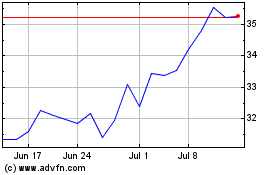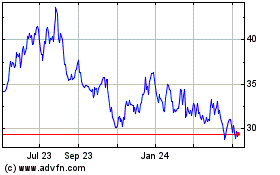By Suzanne McGee
Sometimes, winning simply means that you lose less ground than
everyone else.
That's certainly the definition of "outperformance" for those
actively managed U.S.-stock mutual funds in our quarterly survey at
the end of the first three months of 2020.
In a period that witness the global spread of the Covid-19
pandemic and the end of a long-lived U.S. bull market in stocks,
all of the top performers saw their returns for the rolling 12
months slashed. Chris Retzler, manager of Needham Small Cap Growth
fund (NESGX), watched his gains for the 12-month period ended March
31 plunge to 12.8%, after posting a return for the trailing 12
months ended Dec. 31 of 54.5%.
That performance, nevertheless, was good enough for Mr. Retzler
to win top place in the quarterly Wall Street Journal Winners'
Circle for the second time in a row. The contest measures the
rolling 12-month performance of actively managed, diversified
U.S.-stock funds with more than $50 million in assets and at least
a three-year record. (Index, leveraged and sector funds don't
qualify.) The funds tracked posted an average loss for the trailing
12-month period of 10.8%, according to data from Morningstar.
Mr. Retzler beat out his nearest rival, No. 2 finisher Baron
Opportunity fund (BIOPX), by almost 5 full percentage points in our
survey. Michael Lippert, manager of the Baron fund, generated a
gain of 7.8% for that 12-month period but managed to outperform Mr.
Retzler's fund for the first three months of the year by holding
losses to only 6.7%. The Needham fund recorded a first-quarter loss
of 15.0%.
Adjusting to tumult
Most of the funds in our survey that beat their peers and the
market itself amid the recent volatility and selloffs may not
impress investors by the size of their gains. As disappointed
shareholders often mutter during big downturns, it's tough to
celebrate relative outperformance, as opposed to big absolute
gains. Still, this quarter's winners shielded their investors from
at least part of the damage. They are also adjusting rapidly to the
market tumult.
"It's going to take time to get back to a new normal," says Mr.
Retzler, who admits the rapidity of the market's plunge caught him
off-guard. Still, he had been anticipating some kind of selloff
this year.
"At the end of 2019 we were overweight cash, and we didn't
deploy it," Mr. Retzler says. "We continued to sell in January,
because we felt the economy was likely to slow down," he adds.
"It's hard to sustain the level of activity we've seen, which told
us a correction was needed. Admittedly, this one was more
significant than we thought would occur."
Mr. Retzler believes the selling isn't over.
"It's a new quarter, sure, but I'm not sure it will be all that
much better," he says. He predicts the market will test lows
recorded in March.
"But we think this retest will be incredibly healthy for
creation of the next bull market," he argues. "In the second half
of 2020, we expect to see a significant snapback in global economic
activity, thanks in part to significant stimulus" in the shape of
rock-bottom interest rates and government programs.
That's why Mr. Retzler, like other top performers in this
quarter's survey, is "buying the dip," on a selective basis. He
says he has been adding to his stakes in favorite holdings since
February. In addition, he has established new positions in stocks
that suddenly have become much more affordable, thanks to the 20%
plunge in the S&P 500 index in the first quarter (the largest
since 2008) and the 18.7% dive in the Dow Jones Industrial Average
(the biggest recorded since 1987, before some of the managers in
our survey had even finished high school). "They are trading at
valuations we could never have expected."
Mr. Retzler says that internal compliance rules prevent him from
discussing details about recent trades. Most other managers face
similar constraints.
Looking ahead
In general, however, he says he thinks once the market recovers
it will boost the long-term outlook for companies like online
consumer-loan portal LendingTree, which has been part of his
portfolio off and on in recent years. "It has exposure to a
recovery in consumer spending, and we think when this is over,
consumers will be taking advantage of lower interest rates to
refinance, buy a house or use other LendingTree tools to evaluate
their financial position," he argues.
Mr. Retzler remains a fan of any companies that will benefit
from the rollout of 5G wireless technology and the software sales
business. That has led him, over time, to own stocks like Cohu
Inc., which designs and manufactures semiconductor-testing
equipment. He's also a fan of Limelight Networks Inc., which offers
customers streamed-content-delivery services.
Shares of Limelight, which operates in a segment that is
currently benefiting from the fact that three-quarters of the U.S.
population is indoors, have bounced back from a low of $3.66 in
mid-March to close on Friday at $5.47, near their high of $6.07
recorded in mid-February.
Many of the top-performing funds in the Winners' Circle contest
have continued to attract new inflows of cash from investors.
The market might look like some kind of theme-park terror ride,
but "even this morning, we had flows coming in," says Baron
Opportunity's Mr. Lippert.
Mr. Lippert is putting that money to work in businesses that he
believes will get through the storm not only intact, but with a
stronger market share or competitive edge, such as Zoom Video
Communications (an online platform that quarantined Americans are
using to hold video business meetings, take classes, discuss
book-club selections or virtually share a martini). Other favored
businesses include CrowdStrike Holdings Inc., a cybersecurity
company, and online retailer Amazon.com. He has been eyeing the
health-care area, looking for opportunities to invest in new drug
developments.
"The nature of my portfolio and investment strategy meant that I
didn't own any companies that had liquidity concerns," Mr. Lippert
says. "And since I had been emphasizing the digital transformation
of the economy, I didn't own hotels or cruise lines." Instead, he
had an array of "up and coming" technology businesses on his watch
list that have become more affordable in recent weeks, like Datadog
Inc., which monitors how a client's databases, servers and apps are
performing.
An emphasis on avoiding weak spots and focusing on businesses
that will remain fundamentally strong and recover more rapidly than
the broader economy also buoyed No. 4 finisher Virtus KAR Mid-Cap
Growth fund (PHSKX) for the first quarter of 2020 (it lost 8.3% in
the quarter, less than half the average loss in our survey group).
For the trailing 12 months, its 5.5% gain placed it just behind
another Virtus offering, No. 3 finisher Virtus Zevenbergen
Innovative Growth Stock fund (SAGAX), which recorded a 6.5%
advance.
Like his outperforming peers, Virtus KAR manager Doug Foreman,
the chief investment officer of Los Angeles-based Kayne Anderson
Rudnick (which manages the Virtus funds), continues to buy shares
of those companies he expects to profit most from a recovery. He
also continues to see inflows. "We've seen $200 million of inflows
so far this year," he says, adding that his fund now has about $800
million in assets under management.
Some of that new capital is being directed to businesses like
Domino's Pizza Inc., which has been in the fund for more than seven
years. "People are probably going to order plenty of pizzas, even
in this environment," says Mr. Foreman, who also likes Pool Corp.,
the largest wholesale supplier of swimming-pool supplies and parts.
"Its market share gives it pricing power, and most of its business
comes from people who already have pools, with only a small
percentage tied to new-home construction."
Looking for a sign
Uncertainty about the final toll the new coronavirus will take
might continue to overshadow financial markets. Nonetheless, each
of these three managers remains optimistic about the outlook for
the stock market, which they believe could begin its recovery just
as rapidly as it did in 2009.
"All the markets need at these levels is some kind of sign that
business will get back to normal in the future," says Mr.
Foreman.
When that will be, and what that "normal" will look like,
remains unclear. But the managers see one difference between what
is happening now and market crises of the recent past. This time,
the driving force is a public-health crisis, not market excesses
like a meltdown in subprime bonds, internet stocks in 2000, or even
junk bonds decades ago. Thus, the managers remain upbeat, at least
when they are talking about the long-term market outlook.
"I truly don't know whether we'll be OK in the fall," says Mr.
Lippert. But, he adds, that isn't the point. "We want to look from
point A, today, to a point B that is three to five years out and
not try to guess what's going to happen tomorrow."
Ms. McGee is a writer in New England. She can be reached at
reports@wsj.com.
(END) Dow Jones Newswires
April 05, 2020 22:26 ET (02:26 GMT)
Copyright (c) 2020 Dow Jones & Company, Inc.
Cohu (NASDAQ:COHU)
Historical Stock Chart
From Mar 2024 to Apr 2024

Cohu (NASDAQ:COHU)
Historical Stock Chart
From Apr 2023 to Apr 2024
